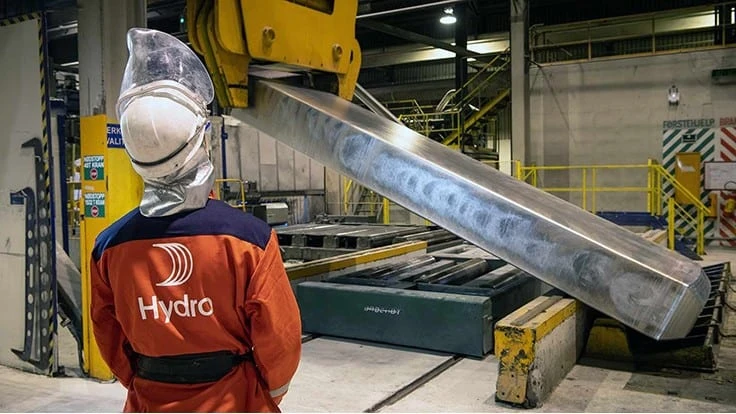
Photo courtesy of Norsk Hydro
Oslo-based aluminum company Norsk Hydro ASA saw third-quarter adjusted earnings before interest, taxes, depreciation and amortization (EBITDA) of $865.9 million (NOK 7,219 million) compared with $371.8 million (NOK 3,100 million) for the same quarter in 2020. The company says its adjusted EBITDA benefitted from higher all-in metal and alumina prices and improved upstream volumes, though higher raw material costs tempered their effects.
President and CEO Hilde Merete Aasheim says, “I am happy to see our organization delivering record quarter results in a strong aluminum market and reaching our full-year improvement target already during [the] third quarter.”
The company says the aluminum market was in deficit during the third quarter in part because energy supply constraints and consumption limitations in China resulted in supply cuts. Outside of that country, demand continued to grow in key segments, such as building and construction, while several disruptions affected supply. As a result, global inventories were reduced during the quarter, and the primary aluminum market for 2021 is expected to be in a deficit, Hydro says.
“World leaders will soon meet at COP26 (United Nations Climate Change Conference) to accelerate action towards the Paris agreement,” Aasheim says. “Aluminum has a strong place in efforts reducing global carbon emissions in support of the green shift. We see increased demand for aluminum used in customers’ solutions to curb emissions. Demand for our low-carbon aluminum offerings continues to increase, while we also are taking strong measures to reduce our own emissions. The fuel-switch project underway at Alunorte will make a solid contribution towards our 30 percent emission reduction target by 2030,” she says of the company’s alumina refinery plant in Brazil.
These market conditions contributed to the increase in the London Metal Exchange cash price for aluminum and aluminum premiums to near-record highs, supporting the record high result in Aluminum Metal of $511.3 million (NOK 4,263 million) in adjusted EBITDA for the third quarter, Hydro says.
The prices of raw materials used in producing alumina and aluminum generally rose during the quarter, as did energy prices. Further, according to the company, energy consumption restrictions have triggered supply cuts for alloying metals such as magnesium and silicon.
Hydro says it has set out a clear strategic direction toward 2025 and aims to strengthen its position in low-carbon aluminum while exploring growth opportunities in new energy. The company adds that sustainability is a key competitive advantage and an enabler for successfully delivering on its 2025 strategy.
The company says its Extrusions segment will benefit from the transition to electric vehicles.
“Electrification of the transport sector is a driver for aluminum demand,” Aasheim says. “By 2035 it is expected that more than 50 percent of vehicles sold will be electric, and battery electric vehicles have around 40 percent more aluminum than a typical combustion vehicle. Hydro is well-positioned to capture this longer-term demand in automotive.”
Hydro also wants to double its recycling of postconsumer scrap (PCS) by 2025. Recently, Extrusions announced that it will upgrade its recycler in The Dalles, Oregon, allowing the site to process an additional 10,000 metric tons, or 11,023 short tons, of PCS annually and increase overall recycled aluminum output by 27,000 metric tons, or nearly 30,000 short tons. This upgrade also will reduce energy consumption and result in lower CO2 emissions and metal costs at the site, according to the company. The investment at The Dalles comes on top of the previously announced recycling investments in 2021 which provide 185,000 metric tons, or nearly 204,000 short tons, of additional cast-house products, based on an additional intake of 65,000 metric tons, or more than 71,500 short tons of PCS.
The company also announced earlier this year that it will add scrap to the recipes at its primary aluminum smelters in Norway.
In Batteries, Hydro’s 50/50 joint venture with Northvolt, Hydrovolt, has ramped up its facility in Norway and is expected to begin recycling batteries by year-end, the company says. Hydrovolt’s order book is full for 2022.
Compared with the second quarter 2021, Hydro’s adjusted EBITDA increased from $791.4 million (NOK 6,598 million) to $865.9 million (NOK 7,219 million) in the third quarter 2021. Higher all-in metal and alumina prices and currency contributed positively to adjusted EBITDA, according to Hydro. This improvement was partly offset by costs upstream, lower volumes and margins in Extrusions and lower Energy production.
Adjusted EBITDA for the first nine months of 2021 increased compared with the same period last year. Higher all-in metal and alumina prices, improved volumes upstream, improved margins and volumes in Hydro Extrusions and better results from Hydro Energy contributed positively to adjusted EBITDA. These positive elements were partly offset by higher raw material costs upstream and negative currency effects, in addition to increased operational costs in Bauxite & Alumina relating to the decommissioning of a crane used to unload bauxite from ships.
Net income from continuing operations totaled $135.2 million (NOK 1,127 million) in the third quarter, which included a net foreign exchange loss of $74 million (NOK 622 million) and $360.4 million (NOK 3,005 million) unrealized loss on LME-related contracts.
Latest from Recycling Today
- BMW Group, Encory launch 'direct recycling’ of batteries
- Loom Carbon, RTI International partner to scale textile recycling technology
- Goodwill Industries of West Michigan, American Glass Mosaics partner to divert glass from landfill
- CARI forms federal advocacy partnership
- Monthly packaging papers shipments down in November
- STEEL Act aims to enhance trade enforcement to prevent dumping of steel in the US
- San Francisco schools introduce compostable lunch trays
- Aduro graduates from Shell GameChanger program





